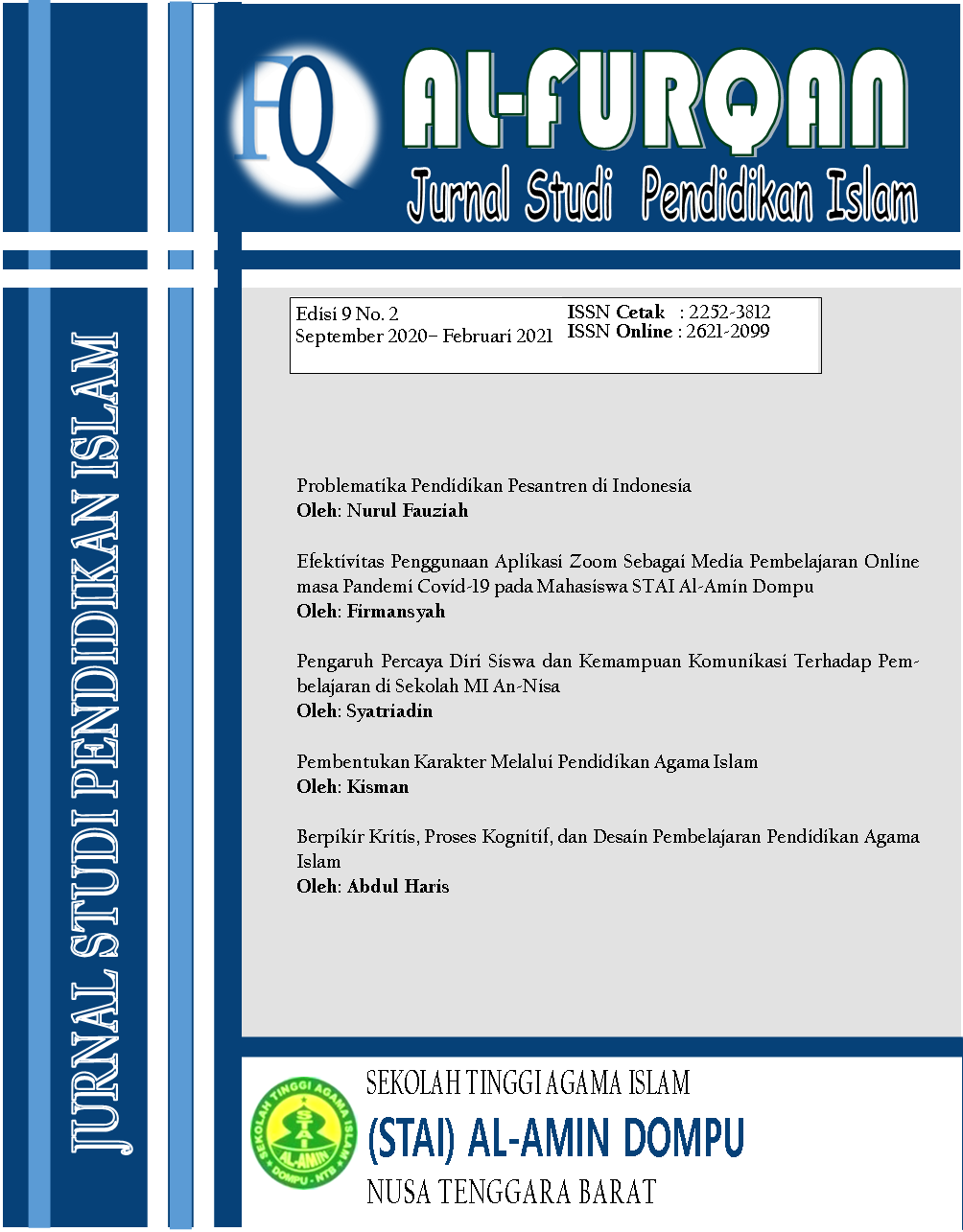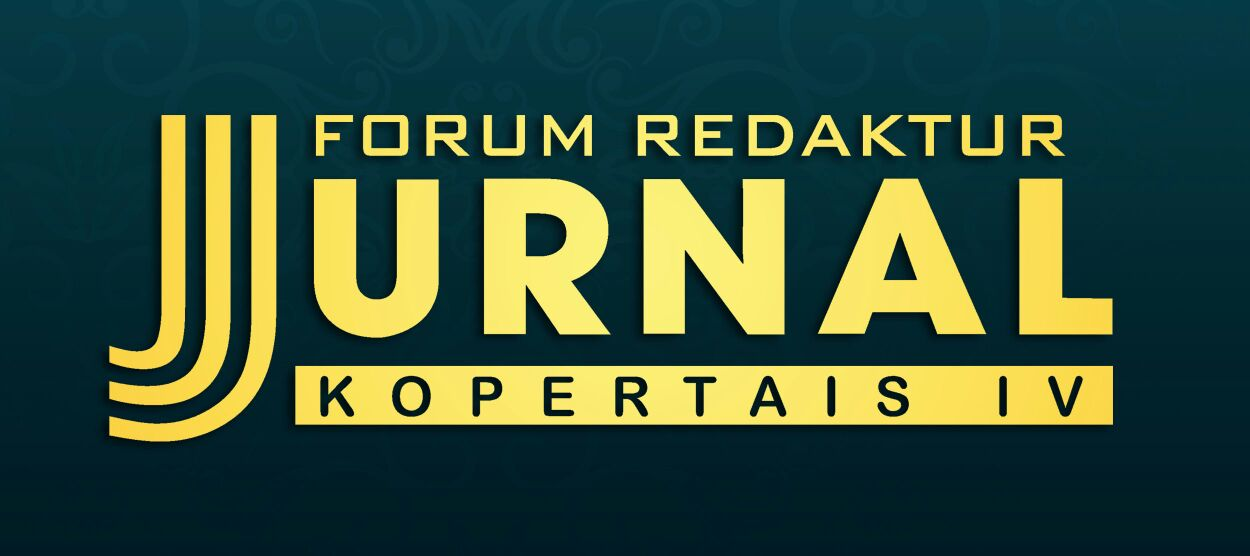Critical Thinking, Cognitive Processes, and Learning Designs of Islamic Religious Education
Abstract
This study aims to analyze the theoretical relationship between critical thinking skills as a cognitive process about the design and planning of Islamic education learning. Learning as a thinking activity (cognitive conflict) is driven by a desire to know. Lecturers should carry out a meaningful learning process that triggers thinking activities. Thinking or cognitive activity is something that is related to or involves cognition as a process of obtaining knowledge because curiosity is through recognition and interpretation through one's own experiences. Learning as a process of structuring or balancing (equilibration) through assimilation and/or accommodation between stimuli as a new problem with cognitive structures or structured knowledge (schemata) as a prerequisite experience. Good learning must take place effectively and meaningfully in a system as a process that accommodates the position, function, and all activities and supports the capacity involved in learning activities. Learning must take place through activities that can trigger cognitive conflict as a process of balancing cognitive structures through assimilation and accommodation. Critical thinking is a mental activity as a whole, comprehensively, and systematically to solve problems and make decisions logically by reflecting on various types of knowledge consistently. Critical thinking skills can be developed through exercises in the learning process. The learning process should be carried out through the use of adequate learning design and planning, which is structured systematically through learning analysis to produce measurable, systematic, and planned student achievement. Student character, learning material, and learning outcomes should be used as basic assumptions in the learning analysis mechanism, to allow cognitive conflict. Learning designs that are adequate, operative, or easy to implement, need to be systematically structured through learning analysis to produce adequate design and planning, which is marked by structuring the overall component relationships as supporting the learning process. Learning analysis activities will facilitate the arrangement of teaching materials, the process of determining learning objectives, character analysis, methods, media, learning strategies, and techniques, as well as learning outcome assessment techniques such as planning assessment instruments and assignment plans, and other considered devices. need. It is undeniable for lecturers to carry out learning activities in a system consisting of many components as the carrying capacity of the whole learning process which can trigger student cognitive conflicts.References
Bayer., B.K. 1995. Critical Thinking. Bloomington: Phi Delta Kappa Educational Foundation
Bloom, Benjamin S. dkk. 1956. Taxonomi of Educational Objectives. The Classification of Educational Goals. (Handbook I: Cognitive Domain) New York: Longman Inc.
Collin, Catherine, dkk. 2012. The Psychology Book. London: DK.
Depdikbud. 1989. Kamus Besar Bahasa Indonesia, Jakarta: Balai Pustaka.
Djamarah, Syaiful B. & Aswan, Z 2006. Straategi Belajar Mengajar. Jakarta: PT Rineka Cipta.
Facione, P.A. 2010. Critical Thinking.: What It Is and Why It Count. Insight Assesment.
Gagne, R.M. 1985. The Condition of Learning Theoryof Intruction. New York: Rinehart.
Galloway, Charels. (1976). Psychology for Learning and Teaching. New York: Mc Graw-Hill Book Co.
Italia & Bahrin, 2018. Kemampuan Berpikir Kritis dan Kemampuan Kognitif Mahasiswa antara Model Pembelajaran PBL dan PBL Menggunakan Media (Power Poin, Vidio, dan CD Interaktif pada Mk Genetika II Prodi Biologi FKIP). Jurnal Pembelajaran Biologi.
Leahey, Thomas H. & Harris, Richard J. (1985). Human Learning. Englewood Cliffs, New Jersey: Prentice Hall, Inc.
Perkins, D.N. & Weber, R.J. 1992. Inventive Mind: Creative in Technology. New York: University Press.
Reilly, Robert R,. dan Lewis, Ernest. 1983. Educational Psychology, Appplication for Classroom Learning and Instruction. New York: McMillan Publ. Co., Inc.
Ruggiero, V.R. (1998). The Art of Thinking. A Guide to Critical and Creative Thought. NYork: Longman, An Imprint of Addison Wesley Longman, Inc.
Soyono & Hariyanto. 2011. Belajar dan Pembelajaran. Bandung: Remaja Rosdakarya
Sternberg, R.J. 2003. Wisdom, Intelligence, and Creativity Synthesized. New York: Cambridge University Press.
Travers, Robert M.W. 1976. Essentials of Learning. 4th ed. New York: McMillan Publ. Co., Inc.
Wina Sanjaya. 2009. Perencanaan dan Desain Sistem Pembelajaran. Jakarta : Kencana
Bloom, Benjamin S. dkk. 1956. Taxonomi of Educational Objectives. The Classification of Educational Goals. (Handbook I: Cognitive Domain) New York: Longman Inc.
Collin, Catherine, dkk. 2012. The Psychology Book. London: DK.
Depdikbud. 1989. Kamus Besar Bahasa Indonesia, Jakarta: Balai Pustaka.
Djamarah, Syaiful B. & Aswan, Z 2006. Straategi Belajar Mengajar. Jakarta: PT Rineka Cipta.
Facione, P.A. 2010. Critical Thinking.: What It Is and Why It Count. Insight Assesment.
Gagne, R.M. 1985. The Condition of Learning Theoryof Intruction. New York: Rinehart.
Galloway, Charels. (1976). Psychology for Learning and Teaching. New York: Mc Graw-Hill Book Co.
Italia & Bahrin, 2018. Kemampuan Berpikir Kritis dan Kemampuan Kognitif Mahasiswa antara Model Pembelajaran PBL dan PBL Menggunakan Media (Power Poin, Vidio, dan CD Interaktif pada Mk Genetika II Prodi Biologi FKIP). Jurnal Pembelajaran Biologi.
Leahey, Thomas H. & Harris, Richard J. (1985). Human Learning. Englewood Cliffs, New Jersey: Prentice Hall, Inc.
Perkins, D.N. & Weber, R.J. 1992. Inventive Mind: Creative in Technology. New York: University Press.
Reilly, Robert R,. dan Lewis, Ernest. 1983. Educational Psychology, Appplication for Classroom Learning and Instruction. New York: McMillan Publ. Co., Inc.
Ruggiero, V.R. (1998). The Art of Thinking. A Guide to Critical and Creative Thought. NYork: Longman, An Imprint of Addison Wesley Longman, Inc.
Soyono & Hariyanto. 2011. Belajar dan Pembelajaran. Bandung: Remaja Rosdakarya
Sternberg, R.J. 2003. Wisdom, Intelligence, and Creativity Synthesized. New York: Cambridge University Press.
Travers, Robert M.W. 1976. Essentials of Learning. 4th ed. New York: McMillan Publ. Co., Inc.
Wina Sanjaya. 2009. Perencanaan dan Desain Sistem Pembelajaran. Jakarta : Kencana
Published
2021-02-24
How to Cite
HARIS, A. Critical Thinking, Cognitive Processes, and Learning Designs of Islamic Religious Education. AL-FURQAN, v. 9, n. 2, p. 43-56, 24 Feb. 2021.
Section
Articles
Copyright (c) 2021 AL-FURQAN

This work is licensed under a Creative Commons Attribution-NonCommercial-NoDerivatives 4.0 International License.






